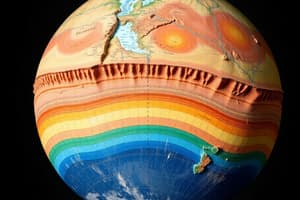Podcast
Questions and Answers
Friction between two tectonic plates sliding
past each, often between two spreading
centers.
Friction between two tectonic plates sliding past each, often between two spreading centers.
Transform fault resistance
The force that opposes slab pull
Occurs when a heavy plate is pulled into the
mantle but resists subduction because of
friction.
The force that opposes slab pull Occurs when a heavy plate is pulled into the mantle but resists subduction because of friction.
Collisional resistance
3-dimensional surface across which there is a significant change in the velocity of
motion of one lithospheric plate relative to the adjacent lithosphere plate.
speed of plate movement: 2cm/year
3-dimensional surface across which there is a significant change in the velocity of motion of one lithospheric plate relative to the adjacent lithosphere plate. speed of plate movement: 2cm/year
Plate boundary
Plates move towards each other
Collision of plates
Destructs or subducts plates
Convergent boundaries creates either a subduction zone or an organic belt
Plates move towards each other Collision of plates Destructs or subducts plates Convergent boundaries creates either a subduction zone or an organic belt
When denser plates subducts or moves underneath the other
When denser plates subducts or moves underneath the other
: Region of deformed rocks, formed when no subduction happens and the 2 plates collide
and compresses.
: Region of deformed rocks, formed when no subduction happens and the 2 plates collide and compresses.
Plates move away from each other
Separation of plates
Forms a new crust
Creates mid-ocean ridges and rift valleys
All oceanic ridges are divergent boundaries
Plates move away from each other Separation of plates Forms a new crust Creates mid-ocean ridges and rift valleys All oceanic ridges are divergent boundaries
also called rift zone
also called rift zone
Plates slide against each other in opposite
directions
Doesn’t create landforms, but produces
earthquakes due to the energy released by the
movement of plates (elastic-rebound theory).
Plates slide against each other in opposite directions Doesn’t create landforms, but produces earthquakes due to the energy released by the movement of plates (elastic-rebound theory).
The force that resists the forces when plates
collide at the boundary in a subduction zone.
The force that resists the forces when plates collide at the boundary in a subduction zone.
Flashcards are hidden until you start studying
Study Notes
Evidences of the Plate Tectonic Theory
- Plate tectonics explain the movement of Earth's lithosphere, which consists of tectonic plates that float on the semi-fluid asthenosphere.
- Southern continents, such as South America and Africa, appear to fit together like pieces of a jigsaw puzzle, suggesting they were once part of a single landmass (Pangaea).
- Fossil evidence, including similar species of plants and animals found on distant continents, indicates those continents were once connected.
- geological similarities, like mountain ranges and rock formations, exist across continents separated by oceans, supporting the idea of their former connections.
- Seafloor spreading occurs at mid-ocean ridges, where new oceanic crust is created, causing tectonic plates to move apart.
- Earthquakes and volcanic activity predominantly occur along tectonic plate boundaries, providing real-time evidence of plate interactions.
- The distribution of earthquakes and volcanoes maps out tectonic plate boundaries, detailing their activity and potential hazards.
- Paleomagnetic studies reveal the historical movement of continents by analyzing magnetic minerals in rocks, showing changes in magnetic orientation.
- The age of oceanic crust is younger near mid-ocean ridges and older further away, supporting processes of plate creation and subduction.
- Radiometric dating of rocks on land and underwater confirms the gradual movement of tectonic plates over millions of years.
Studying That Suits You
Use AI to generate personalized quizzes and flashcards to suit your learning preferences.




